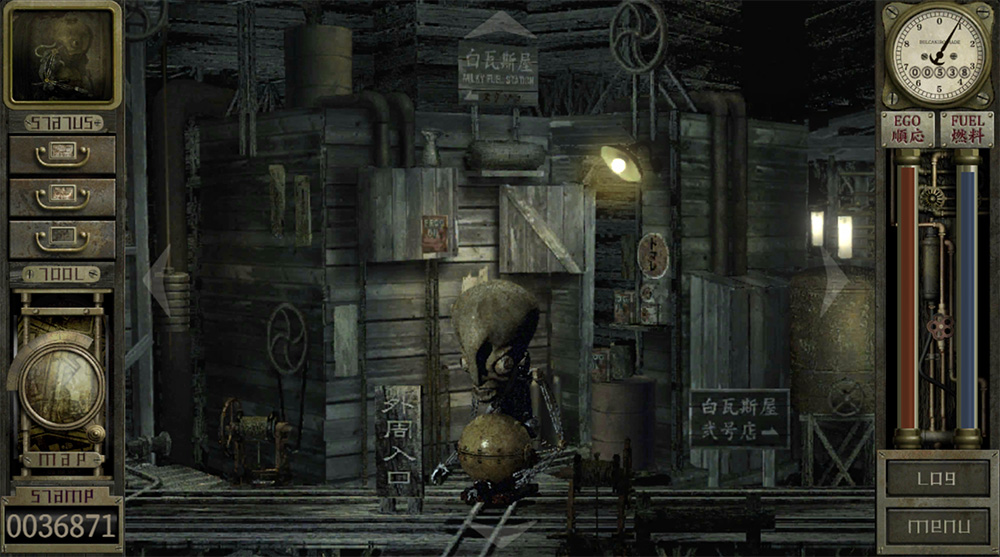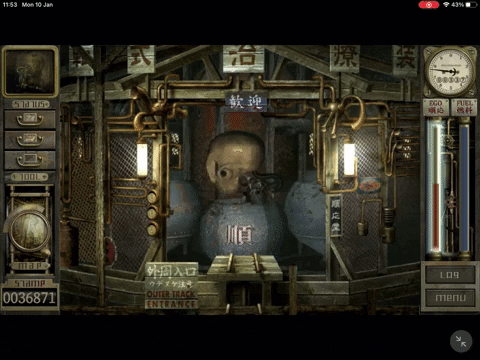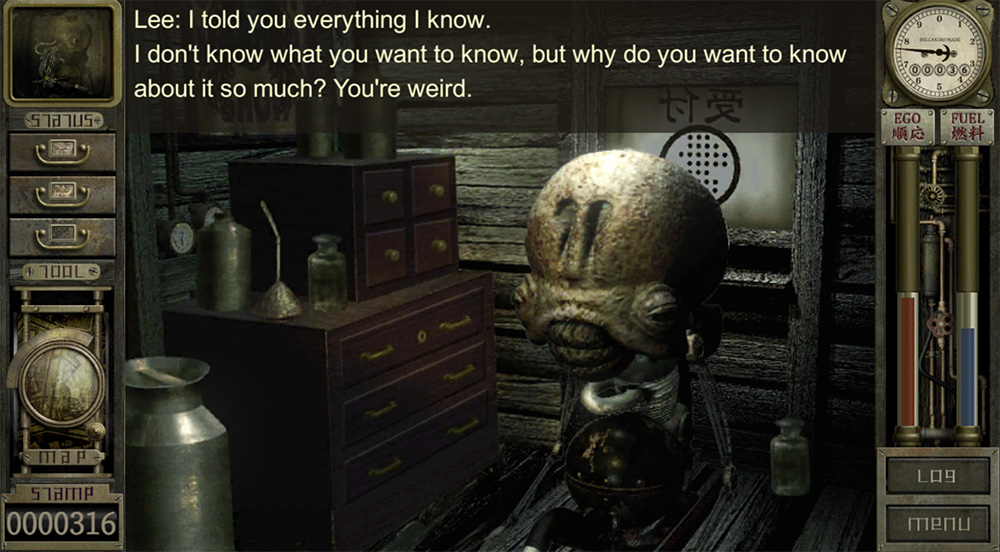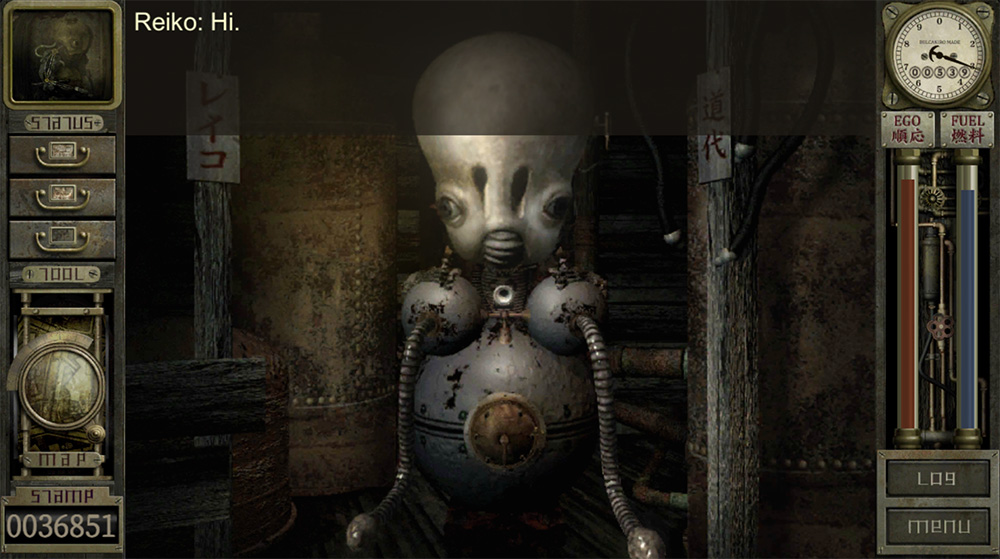It’s not often I pick up a game based solely on a tweet, or find myself so enthralled by a game that I need to review it just to see more people talking about it, but here we are! Garage: Bad Dream Adventure came out on iOS and Android for the first time in English on December 16, 2021, and despite being an obscure Japanese video game with a unique, unsettling vibe, I’d never heard about it before my Twitter friend @furnuss posted about the release. (Update: As of July 2022, it is also available on PC!)
Immediately intrigued, I read up on the original game from 1999 and its journey to finally being released in English and knew I had to check it out. Since there seems to be very little talk about this exciting release, I had to share the news and my thoughts after fully completing the game!
Garage: Bad Dream Adventure is the brainchild of artist and designer Sakuba Tomomi, originally released in a run of only 3,000 units for PC and Mac in Japan in 1999 under the title Garage. Tomomi also illustrated a 1992 Japanese edition of Alice in Wonderland, and it’s no wonder – his art, just like the premise of Garage, is eerie and disquieting, but whimsical at the same time.
Despite being re-released in limited quantities through Tomomi’s personal website in the early 2000s, Garage was virtually inaccessible outside of Japan until a fan got their hands on a copy and uploaded the full game online in 2014. This, along with a few gameplay videos and trailers, fueled the interest in this notoriously weird game. While there was a fan translation, English-speaking fans had no official way of playing the game until a successful Campfire fundraising campaign funded a remaster and English and Chinese localizations.

The remaster, titled Garage: Complete Edition aimed to have a number of improvements beyond remastered graphics and being ported to smartphones. Tomomi writes that the original game was developed in 2.5 years, and while he did the best he could do at the time, he wanted to expand the game to have more story elements and better gameplay balance so that it could be enjoyed by even more people. The new, expanded story has 1.5 times the text of the original, providing more insight into the world and characters. Balance improvements to the gameplay include showing the player character’s position on the map and adding arrows to the screen to show what direction you can move to.
As someone who doesn’t play a lot of classic adventure games due to the difficulty often necessitating the use of a guide in order to proceed through the game, I greatly appreciate all of these additions. The game plays very smoothly, with characters almost always indicating clearly in the text what you should do or who you should talk to next. Over the 12 or so hours it took me to finish the game, I only really felt frustrated on two occassions where it’s not as clear what you need to do next.
So what kind of game is Garage: Bad Dream Adventure exactly? In essence, it is a bizarre point-and-click adventure game where you control an alien/fetus-like robot that lives in a sewer with a host of other, similarly creeply-looking, robots. When you wake up in your room, a series of notes provide a vague sense of how to proceed, and you slowly learn more about the nightmarish, grimy world of the sewer.
Aside from the striking visual design of both the characters and the world, the subtle soundtrack adds to the game’s unsettling atmosphere. It’s never scary, but something’s always a little off, and all the more so when you start to discover how things run in the sewers. Namely, male robots need to refuel by receiving milky fuel from female robots, which they create by eating crabs you catch throughout the sewer.
As a male robot, you have a fuel meter, and need to stop to refuel regularly throughout the game. The first time I had to do this I was rather shocked by exactly how the refueling actually works, but the phrase “milky fuel” probably gives you something of an idea. What first is just a necessity to keep your robot running slowly becomes a key aspect of the story as you realize how much the sewer world revolves around the availability of milky fuel and the female robots that provide it.
If it’s not clear from that description, the physiology of the robot bodies is a big focus of the game, and there is some body horror-style content. Again, I would not say this game is horrific or looking to scare the player specifically, but if weird body things bother you, it might be a good idea to do a quick Google to see if some of the imagery in the game bothers you before playing. There is also some subtle and somewhat less subtle nudity and sexual innuendo in the game, so be warned that this game isn’t really for children (though I know I wouldn’t have been able to play a game this creepy as a child!).
Gameplay-wise, you spend most of your time wandering around the sewer using an intricate track system built for the robots, learning about the surreal world by talking with the different characters, fishing, and upgrading your character’s robot body. In addition to fuel, you also have a limited amount of Ego – if your Ego gets too low, you’ll become “word lost” and unable to speak with the other robots. You can refuel your ego in a carousel or a pod – I have no idea why there is a carousel and it costs more to use than the pods, but you definitely need to try it at least once, because it’s weirdly adorable to see a fetus alien robot ride on a grimy theme park carousel.

Another major component of the game is fishing and setting bottle traps to catch bait, which can be used or traded for the game’s currency. I hope you like fishing, because there is a surprising amount of it, especially later in the game, as one of the major advancements in the story is directly related to catching one of the hardest fish to catch the game. To catch a fish, you’re required to tap the bar on the right-hand side of the screen and drag it up and down until the fish’s health meter is fully depleted, which gets harder as you go along. I found it easy to control on the iPad, but I could see it being a bit frustrating to manage on a smaller phone screen.
If you asked me whether I ever fully understood the story of Garage, the answer would be a resounding “no.” But I’ll be darned if I didn’t thoroughly enjoy every minute of this game! I’ve never played anything quite like it, and the enhancements made for the complete edition keep it from ever getting too frustrating (aside from the fact that I never fully remembered how to navigate in the game). I just wanted to keep exploring the world, talking to the weird characters that inhabit it and seeing what whacky thing would happen next.
I know there is probably a rather limited audience for Garage due to how weird it is both visually and from a story perspective, but if you made it through this review and have any mind to try it, I urge you to go download it immediately. It looks and runs great on iOS (the version I tried), and the English localization is very solid. It’s available for a steal at $4.99 on the North American iOS and Android* stores, and it is by far one of the most impactful gaming experiences I’ve had in years.


